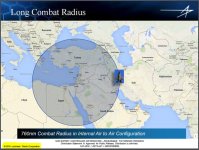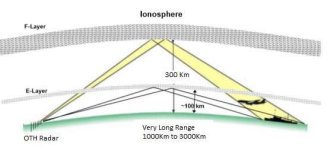Learn the difference between detecting and targeting.
They are two different things in the radar world.
Some radars can detect at far ranges, but its a general location and cannot be used for target acquisition, but it helps other radars know which sectors/quadrants to scan.
I don't need to learn because I know the difference. Still, detecting fighters at ranges of 900-2,000 km is highly speculative and depends on several factors. It is simply impossible for an OTH radar to detect a LO/VLO fighter flying at medium altitude at a range of 800 km, even if it had an antenna as high as 50 meters. As I said, detecting aircraft can be done at such great ranges, but only depending on the aircraft type, RCS and its altitude.
And all these RCS m2 you quote are frontal RCS meaning if the radar waves hit from the front (ie object flying towards), nothing hits perfectly from the front that’s lab testing/radar room. F-22 actually worked to reduce RCS on all sides.
The quadrant of greatest interest is the aircraft's forward RCS. As a rule, when we talk about an aircraft's RCS, we are referring to the RCS in the X-band of its forward quadrant. The rear RCS is the second most important and is usually slightly higher than the forward RCS. A side, top or bottom view of the aircraft will usually show a much higher RCS than the front quadrant. The RCS varies with the aircraft's viewing angle and the frequency of the radar signal; normally the lower the radar frequency, the higher the RCS. The frequency band of greatest concern is the band in which fire control radars (radars capable of providing a firing solution for missiles) operate, especially the X-band (8-12GHz), which is the band most used by SAMs and fighter aircraft.
Regarding the difference between an F-22 and an F-35, in 2014, General Hostage, head of Air Combat Command, said: “
The radar cross section of the F-35 is much smaller than the F-22, but that does not mean that the F-35 is necessarily superior to the F-22 when we go to war.” For those wondering about the value of the opinion of a general sitting behind a desk, know that Hostage flew the F-22, as well as most models of the F-15 and F-16. Hostage’s statements caused some stir, contradicting independent analysis and conventional wisdom on low-observability techniques that pointed to the F-22 as a stealthier aircraft. But according to Lt. Gen. Christopher C. Bogdan: “
I would say that General Hostage was accurate in his statement about the stealth level of the F-35.” He also scoffed at the notion that anyone can tell how stealthy an aircraft is just by looking at it.
Well, I'm not going to post comments from someone who's flown both fighters here. The F-22 has a more disciplined surface than the F-35, meaning it has fewer protrusions along the fuselage, especially on the underside. The mitigating factor is that the F-35’s bulges follow the stealth shape rule (a gentle curvature) and have very little effect on the RCS in the forward aspect, since the bulges represent a fraction of the fuselage cross-section relative to the forward aspect. The F-22’s exhaust nozzle also uses a more stealthy design. Two angled wedge-shaped “petals” form a 2D nozzle with only two large edges each. Meanwhile, the F-35 uses an axisymmetric nozzle with several small “petals” with angled edges that control the reflection direction a little less, and also use smaller edges with greater potential for interaction with waves. As with the fuselage bulges, the mitigating factor is that the nozzle has little effect on the forward RCS.
The F-22 uses a traditional splitter plate air intake to divert the boundary layer away from the engine inlet, thus creating an inappropriate space between the air intake and the fuselage in terms of stealth; the F-35 uses diverterless-supersonic inlets (DSI), which are essentially more stealthy and eliminate complex and heavy mechanical systems. The DSI inlet has a large bulge in the fuselage with a gentle curvature that can divert turbulent air from the boundary layer. The bulge also deflects radar waves by obeying well-defined shape criteria, further reducing the field of view to the engine and absorbing radar waves with a thick layer of RAM. In the rear aspect, the great innovation in the F-35 was the adoption of an afterburner system that acts as a true blocker in the exhaust duct to mask the turbine, which, like the engine fan in the front aspect, is a large source of radar reflection, in addition to IR emission. The F-22 also has a “stealth” afterburner system, but without the masking capabilities of the F-35 system.
Manufacturing tolerance (the limit of permissible inaccuracy for a part) is one of the key factors in building a stealth aircraft. The F-22, for example, had manufacturing tolerances of 1/10,000th of an inch. The F-35 production line is orders of magnitude more precise than the F-22, which was built using comparatively dated manufacturing techniques. The F-35 team is employing advanced assembly methods and high-precision manufacturing machines; new milling machines with precision less than the width of a human hair ensure that the external shape of the F-35 is accurate and meets stealth requirements. Reducing or nearly eliminating gaps between structural parts is highly desirable to achieve stealth characteristics in an aircraft. In fact, one of the reasons the F-35 uses fewer stealth coatings and gap fillers is due to the extremely tight manufacturing tolerances. The more precise the fuselage assembly, the easier it is for the current induced by an illuminating radar to travel through the skin of the aircraft. This induced current, when it encounters any discontinuity, radiates radar waves back to the illuminating radar.
Another area where the F-35 has advanced over the F-22 is in stealth materials. Everything that was observed during the F-22 operations served to improve the materials for the F-35. The F-35 is made of composite material in approximately 42% of its weight, compared to 22% in the F-22 and 2% in the F-16. The F-35 contains a layer of fiber mat (fibermat) cured directly on the fuselage that eliminates the layer of “conductive paint” found in the F-22, “completely eliminating” this dangerous and difficult-to-apply substance. Conductive paint uses silver in its composition to provide conductivity to the fuselage and make it opaque to radar waves so that they do not penetrate the fuselage and reflect off the aircraft's internal components. While conductive paint is relatively sensitive to pressure and chemicals such as fuel and oil, the F-35's fiber carpet is only affected if the fuselage is actually damaged.
In addition to several other complementary factors, the result, clearly, is that the F-35's stealth system is an order of magnitude reduction in maintenance compared to all other stealth systems. Not surprisingly, in fiscal year 2020, the F-35A was the USAF's most mission-capable fighter aircraft, achieving 76.07% availability versus 51.98% for the F-22, even surpassing legacy aircraft such as the F-16 and F-15.
Lastly they are assuming no drop tanks or armaments on hard points (stealth configuration), that means much less ammo since the internal weapon bay is quite limited plus the need to carry A2A for self protection.
This would definitely increase the RCS and there is no point in arguing about that. But again, even at this point, an OTH radar is still unlikely to detect a VLO fighter at ranges of 900-2,000 km.
So F-35 you quote is lab RCS with no hard points and stealth configuration heading to Iran and only being hit by radar directly from the frontal section.
Unrealistic to say the least.
No. What I am claiming is the impossibility of an OTH radar detecting a VLO fighter at ranges of 900-2,000 km. This is the
unrealistic scenario of the debate here.









